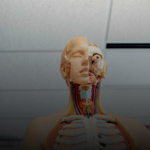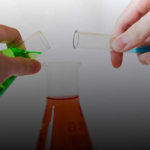Section 1
Preview this deck
26) The average heart beats about ________ times per minute. A) 35 B) 50 C) 75 D) 105
Front
Active users
1
All-time users
1
Favorites
0
Last updated
1 year ago
Date created
Mar 1, 2020
Cards (93)
Section 1
(50 cards)
26) The average heart beats about ________ times per minute. A) 35 B) 50 C) 75 D) 105
C) 75
18) When ventricles ________, the AV valves are closed. A) relax B) open C) contract D) dilate
C) contract
40) Branches of the common carotid arteries, known as the ________, travel through the neck into the skull through the temporal bone to supply the brain and cerebral arterial circle (circle of Willis) with blood. A) external carotid arteries B) internal carotid arteries C) brachiocephalic trunk D) subclavian arteries
B) internal carotid arteries
38) Veins draining the head and arms empty into the ________, which carries blood to the right atrium of the heart. A) superior vena cava B) inferior vena cava C) common iliac vein D) great saphenous vein
A) superior vena cava
44) The alternating expansion and recoil of an artery that occurs with each beat of the left ventricle creates a pressure wave known as a(n) ________. A) cardiac output B) pulse C) pressure point D) stroke volume
B) pulse
28) The vagus nerve operates under the control of the parasympathetic nervous system and causes the ________. A) heart rate to decrease B) heart rate to increase, then decrease C) heart rate to increase D) blood pressure to increase
A) heart rate to decrease
35) The largest artery in the body is the ________. A) brachiocephalic artery B) pulmonary trunk C) aorta D) common carotid artery
C) aorta
6) The layer of the heart wall that receives the stimulus from letter E is called the ________. A) pericardium B) epicardium C) endocardium D) myocardium
D
34) The flow of blood through a capillary bed is called ________. A) pulmonary circulation B) hepatic portal circulation C) systemic circulation D) microcirculation
D) microcirculation
47) Fluid tends to be forced out of a capillary bed by ________ while ________ tends to draw fluid into the capillary bed. A) systolic pressure; diastolic pressure B) blood pressure; osmotic pressure C) osmotic pressure; diastolic pressure D) osmotic pressure; blood pressure
B) blood pressure; osmotic pressure
21) The length of the cardiac cycle is normally ________ second(s) in length. A) 2 B) 4 C) 0.8 D) 0.3
C) 0.8
2) The sinoatrial (SA) node is indicated by ________. A) Label A B) Label B C) Label C D) Label D E) Label E
Label A
3) Pulmonary circulation involves blood flow to and from the heart and the ________. A) body B) digestive organs C) skin D) lungs E) brain Answer: D Page Ref: 360 Bloom's: 1) Knowledge
D) lungs
23) The first heart sound, "lub," is caused by the closure of the ________ valves. A) semilunar B) pulmonary C) atrioventricular (AV) D) aortic
C) Atrioventricular (AV)
46) Sustained elevated arterial blood pressure above 140/90 mm Hg is a condition known as ________. A) hypertension (high blood pressure) B) orthostatic hypotension C) circulatory shock D) myocardial infarction
A) hypertension (high blood pressure)
37) The longest veins in the body drain the leg and are the ________. A) femoral veins B) great saphenous veins C) venae cavae D) anterior and posterior tibial veins
B) great saphenous veins
15) Oxygented blood nourishing the myocardium comes from vessels that branch off the aorta called ________. A) pulmonary arteries B) pulmonary veins C) coronary arteries D) venae cavae
C) coronary arteries
2) The layer of the heart wall synonymous with the visceral layer of the serous pericardium is ________. A) myocardium B) endocardium C) epicardium D) parietal layer of the serous pericardium E) either endocardium or epicardium
C) epicardium
3) The atrioventricular bundle (bundle of His) is represented by ________. A) Label A B) Label B C) Label C D) Label D E) Label E
C
9) The visceral layer of the serous pericardium is actually the same layer as the ________. A) epicardium B) myocardium C) fibrous pericardium D) endocardium
A)epicardium
1) The heart is situated within the medial section of the thoracic cavity known as the ________. A) mediastinum B) hiatus C) pleural cavity D) hilus E) diaphragm
A) mediastinum
42) The flaplike opening in the interatrial septum of the fetus through which blood is shunted directly from the right atrium to the left atrium is the ________. A) ductus arteriosus B) ligamentum arteriosum C) ductus venosus D) foramen ovale
D) foramen ovale
22) The electrocardiogram (ECG) wave that results from the firing of the sinoatrial (SA) node is the ________ wave. A) QRS B) T C) P D) S-T
C) P
25) During mid-to-late diastole, blood flows from the atria to the ________. A) ventricles B) lungs C) aorta D) pulmonary trunk
A) ventricles
33) Large veins have ________ to prevent the backflow of blood. A) tunics B) sphincters C) valves D) shunts
C) valves
19) The coronary veins empty blood from the myocardium into a large vein on the posterior side of the heart known as the ________. A) pulmonary vein B) inferior vena cava C) superior vena cava D) coronary sinus
D) coronary sinus
41) The vessel that carries oxygenated and nutrient-rich blood to the fetus is the ________. A) hepatic portal vein B) umbilical vein C) ductus arteriosus D) umbilical artery
B) umbilical vein
14) The tiny white cords that anchor the cusps or flaps of endocardium to the walls of the ventricles are called the ________. A) chordae tendineae B) ligamentum arteriosum C) ductus venosus D) myocardium
A) chordae tendineae
12) Blood leaves the left ventricle through an artery known as the ________. A) pulmonary trunk B) aorta C) superior vena cava D) coronary sinus
B) aorta
45) The narrowing of blood vessels is known as ________. A) vasodilation B) diastole C) vasoconstriction D) systole
C) vasoconstriction
16) The walls of the ________ are substantially thicker because that chamber acts as the more powerful systemic pump of the heart. A) left atrium B) left ventricle C) right atrium D) right ventricle
B)left ventricle
29) Large blood vessels that carry blood away from the heart are called ________. A) arteries B) capillaries C) veins D) venae cavae
A) arteries
5) The bundle branches are indicated by ________. A) Label A B) Label B C) Label C D) Label D E) Label E
Label D
11) The valves located between the atria and ventricles are known as the ________ valves. A) pulmonary B) atrioventricular (AV) C) aortic D) semilunar
B) atrioventricular(AV)
10) The two superior receiving chambers of the heart are known as the ________, while the two inferior discharging chambers of the heart are known as the ________. A) ventricles; atria B) atria; ventricles C) arteries; veins D) veins; arteries
B) atria;ventricles
32) Capillary beds are drained by vessels known as ________. A) venules B) venae cavae C) arterioles D) arteries
A) venules
36) The organs served by the renal arteries and veins are the ________. A) ovaries B) kidneys C) testes D) lungs
B) kidneys
30) Tunica ________, the middle layer of a typical blood vessel, contains smooth muscle and elastic fibers. A) intima B) externa C) media D) adventitia
C) media
27) The volume of blood pumped out of a ventricle with each heartbeat is known as ________. A) heart rate (HR) B) stroke volume (SV) C) cardiac output (CO) D) blood pressure (BP)
B) stroke volume (SV)
13) The transportation of blood from the right side of the heart to the lungs and back to the left side of the heart is known as ________ circulation.
C)pulmonary
43) The pressure that draws fluid into capillaries since blood has a higher solute concentration than interstitial fluid is known as ________. A) blood pressure B) systolic pressure C) osmotic pressure D) diastolic pressure
C) osmotic pressure
24) The term that means heart contraction is ________. A) diastole B) tachycardia C) systole D) fibrillation
C) systole
4) The atrioventricular (AV) node is indicated by ________. A) Label A B) Label B C) Label C D) Label D E) Label E
Label B
20) The sinoatrial node, located in the right atrium of the heart, is often called the ________. A) pacemaker B) pericardial cavity C) atrioventricular (AV) bundle (bundle of His) D) auricle
A)pacemaker
17) The bicuspid valve is also referred to as the ________ valve. A) mitral B) pulmonary C) semilunar D) aortic
A) mitral
39) The single vessel that drains blood from the digestive tract organs to the liver is the ________. A) hepatic vein B) hepatic portal vein C) renal vein D) inferior vena cava
B) hepatic portal vein
7) The partition where the bundle branches are located is called the ________. A) left atrioventricular groove B) interatrial septum C) interventricular septum D) right atrioventricular groove
C) interventricular septum
1) The Purkinje fibers are indicated by ________.
E) Label E
8) The pointed, inferior portion of the heart, known as the ________, rests on the diaphragm and is oriented toward the left hip. A) base B) mediastinum C) apex D) pericardium
C)Apex
31) Arteries are normally depicted as red while veins are colored blue. The exceptions to this rule are the ________ arteries and veins. A) systemic B) hepatic C) coronary D) pulmonary
D) pulmonary
Section 2
(43 cards)



